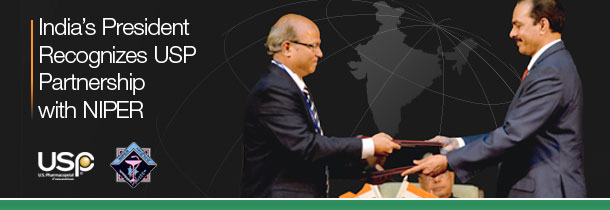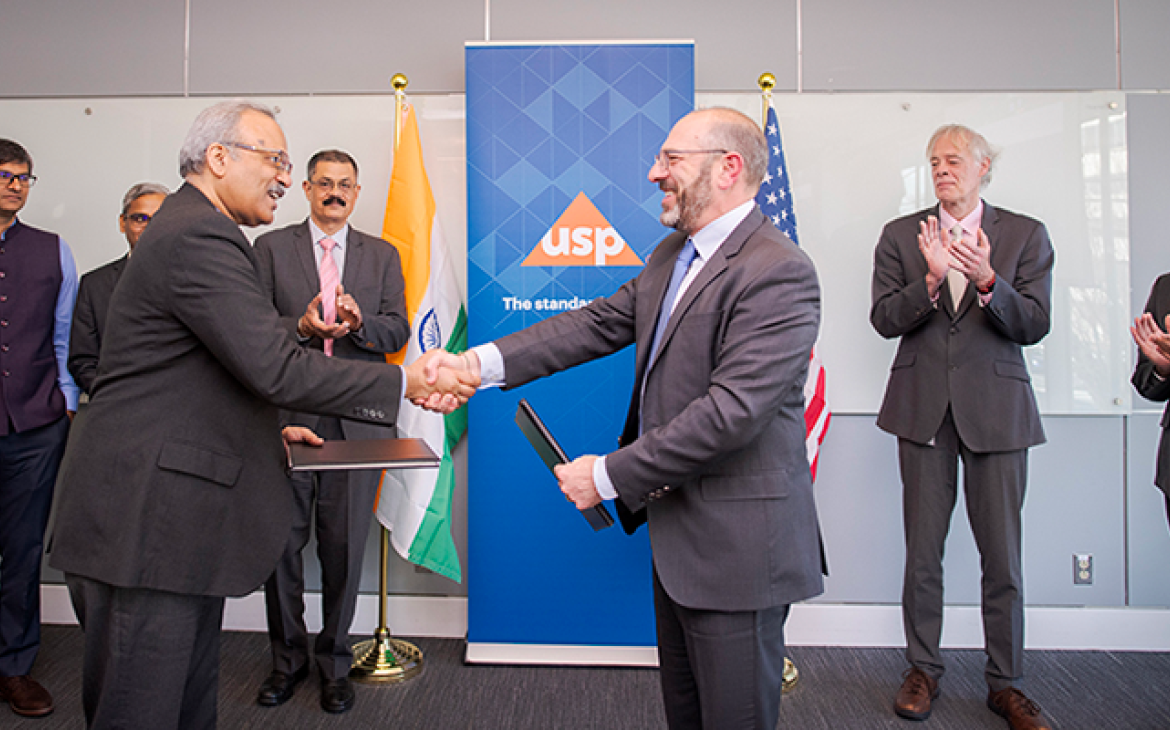
NIPER Project Director, Dr. R. Srinivas (left), and USP Senior Vice President-Global Sites, Koduru Surendranath, Ph.D. (right), agree to academic exchange focused on pharmaceutical expertise building while Indian President Pranab Mukherjee looks on. (Photo courtesy of President's Secretariat and National Informatics Center)
By Koduru V. Surendranath, Ph.D. | USP Senior Vice President, Global Sites
For the last 8 years, USP India has supported an academic exchange program with the National Institutes for Pharmaceutical Education and Research (NIPER) in Hyderabad, India. USP scientists on several occasions have given guest lectures at the academy, and USP has invited some of NIPER’s best students to work as interns at USP’s Hyderabad office. These activities were recently formalized in a Memorandum of Understanding (MOU). And a month later, on November 16, 2016, this MOU and the partnership it represents were recognized by the President of India, Pranab Mukherjee, who also serves as Visitor of 126 central institutes of higher learning, at the second Visitor’s Conference organized by Confederation of Indian Industry (CII).
I was pleased to represent USP during the ceremony at Rashtrapati Bhavan, India’s Presidential residence, that recognized our MOU with NIPER and several similar programs. We view USP’s partnership with NIPER as an investment in global medicines quality by building India’s expertise and capacity for pharmaceutical quality. But the benefits of this relationship extend well beyond NIPER and India.
Academic and industry partnerships are an important part of the Indian government’s strategy for growth. Speaking at the ceremony, President Mukherjee explained, “The higher education sector has a crucial role in the national developmental effort.” He added that “the quality of training provided to students employed by this sector determines the level of industrial competence” and “A strong interface between these two core sectors (industry and higher education) will have positive spin-offs for the entire economy.”
Indeed, India’s knowledge-intensive science- and technology-based industries have helped South Asia outperform an otherwise sluggish global economy to become the fastest growing region in the world according to the World Bank.
USP’s mission is to improve public health worldwide by advancing public standards and programs that help ensure the quality, safety, and benefit of medicines and foods. Although the USP-NIPER exchange program is small, it has an outsize impact on improvements in global medicines quality.
That is because India occupies a unique position in the global pharmaceutical market.
Participants in the USP-NIPER exchange program recently reflected on the value of the USP-NIPER exchange program and its contributions to global medicines quality, the Indian economy, and their own professional development.
Although five industrialized countries (US, Japan, Germany, France, and the UK) account for two-thirds of the value of medicines produced globally, this view gives a misleading picture when considering their therapeutic value. That’s because many of the most expensive innovator drugs offer only modest therapeutic gains. Whereas, generics—though inexpensive—represent some of the most widely used, safe, and beneficial medicines. Three program participants I spoke with, Dr. M.V. Narendra Kumar Talluri, PhD, MRSC, a professor at NIPER Hyderabad; and Debasish Swain and Chiguru Vishnuvardhan, two PhD research scholars from the academy—all pointed with pride to the fact that India’s pharmaceutical industry is the largest provider of generic medicines globally.
India has over 10,000 pharmaceutical manufacturers. Many produce medicines for local consumption, but since 1985, the export share of production has tripled. Today, India supplies 20% of the global volume. Indian pharma exports reached US $15 billion in 2015 and are forecast to reach US $18 billion in 2016.
Although many of India’s factories are world-class and virtually indistinguishable from their counterparts in the West, others suffer from serious quality control problems. The World Health Organization estimates that one in five drugs made in India are fake. However, increased exports are translating into increased pressure to meet international standards of quality.
 “The regulatory bodies have been tightening up their grip on the pharmaceutical industries, forcing them to adhere strictly to quality guidelines. In order to provide quality generic medicines to the patients at par with the innovator’s product, the Indian pharmaceutical industry has to play a very significant role in complying with the rigorous global regulatory environment.”
“The regulatory bodies have been tightening up their grip on the pharmaceutical industries, forcing them to adhere strictly to quality guidelines. In order to provide quality generic medicines to the patients at par with the innovator’s product, the Indian pharmaceutical industry has to play a very significant role in complying with the rigorous global regulatory environment.”
- Dr. M.V. Narendra Kumar Talluri, PhD, MRSC | Professor, NIPER Hyderabad
 It's not only regulatory bodies demanding quality. “The generic market is growing fast, and above all the customers are now much more alert and educated. [The demand for] quality and quantity are now proportional to one another.”
It's not only regulatory bodies demanding quality. “The generic market is growing fast, and above all the customers are now much more alert and educated. [The demand for] quality and quantity are now proportional to one another.”
- Debasish Swain | PhD Research Scholar, NIPER Hyderabad
The USP-NIPER academic exchange is intended to help India’s rapidly growing pharmaceutical industry meet these demands.
“Certainly USP India is having a great impact on the quality of pharmaceuticals in India. Its urge to produce monographs and specifications for quality standards indicates its potential contribution to maintain quality of pharmaceuticals in India and around the globe,” said Ch. Vishnuvardhan
By investing in one of India’s principal sources of professional manpower—higher education and research in pharmaceutical sciences—USP is investing in strengthening the Indian pharmaceutical industry’s capacity for producing quality products.
“USP played a great role in grooming my skills to become a good analyst. The scientific discussions with my guide at USP and the scientists working in the laboratories enhanced my knowledge and enriched my concepts on the various applications of analytical science,” said Swain.
 “I was [a] USP intern while pursing my M.S. in Pharmaceutical Analysis at NIPER Hyderabad. The motivation factor was to learn from the best of the analytical labs. The most valuable things I learned at USP were how to plan, execute, and report experimental data in a specified manner. Planning experiments and performing them to perfection was inculcated into me.”
“I was [a] USP intern while pursing my M.S. in Pharmaceutical Analysis at NIPER Hyderabad. The motivation factor was to learn from the best of the analytical labs. The most valuable things I learned at USP were how to plan, execute, and report experimental data in a specified manner. Planning experiments and performing them to perfection was inculcated into me.”
- Chiguru Vishnuvardhan | PhD Research Scholar, NIPER Hyderabad
But the benefits of the program may be even greater. “The experience helped (the students) in their quality contribution in various R&D projects of global pharmaceutical importance,” explained Dr. M.V. Narendra Kumar Talluri, PhD, MRSC.
The program “provided me with a firm platform for learning and exploring the concepts of drug discovery and development,” said Swain. And Ch. Vishnuvardhan said the program “will motivate the upcoming generations to take up pharmaceutical research in India.”
In short, the program is a win-win. USP’s investment in pharmaceutical expertise and capacity benefits India’s rapidly growing pharmaceutical industry which in turn strengthens the Indian economy and improves the quality of medicines in the United States and globally.


